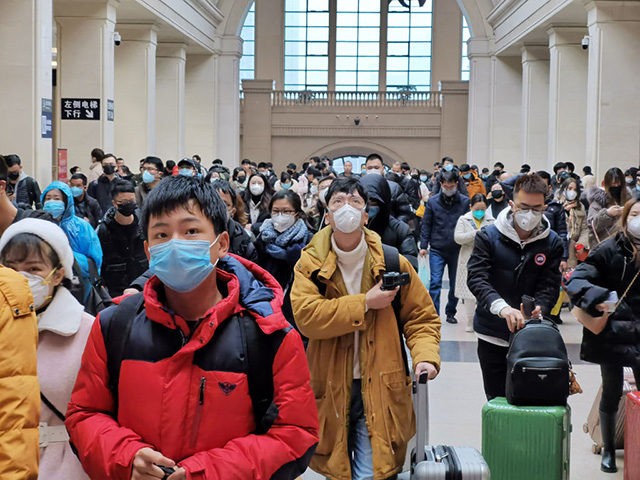The total number of known and acknowledged coronavirus cases around the world surpassed 100,000 over the weekend. As of Monday morning, there were 111,356 cases worldwide, with 3,892 fatalities.
MarketWatch noted that last week China accounted for 89 percent of total cases and 95 percent of coronavirus deaths, but this week the percentages have shifted to 72 percent and 77 percent respectively, showing “how quickly the outbreaks in Iran, Italy, and South Korea have expanded.” The United States currently has 564 coronavirus cases and 22 deaths.
“As we mark this somber moment, the WHO reminds all countries and communities that the spread of this virus can be significantly slowed or even reversed through the implementation of robust containment and control activities,” the World Health Organization (WHO) said in a statement on Saturday.
“WHO calls on all countries to continue efforts that have been effective in limiting the number of cases and slowing the spread of the virus. Every effort to contain the virus and slow the spread saves lives. Allowing uncontrolled spread should not be a choice of any government, as it will harm not only the citizens of that country but affect other countries as well,” the statement added.
WHO noted that slowing the spread of the virus as much as possible gives medical systems, governments, and societies more time to prepare for the impact of the virus and develop effective mitigation strategies and treatments, hopefully culminating soon with the deployment of vaccines.
Writing at the New York Post on Sunday, attorney and author Michael Fumento saw reason for optimism at the 100,000-patient mark, noting that the coronavirus appears to have a reasonably short span of peak and decline, with far fewer infections at its peak than diseases which receive far less attention:
Worldwide, there have been about 3,400 coronavirus deaths, out of about 100,000 identified cases. Flu, by comparison, grimly reaps about 291,000 to 646,000 annually.
China is the origin of the virus and still accounts for over 80 percent of cases and deaths. But its cases peaked and began declining more than a month ago, according to data presented by the Canadian epidemiologist who spearheaded the World Health Organization’s coronavirus mission to China. Fewer than 200 new cases are reported daily, down from a peak of 4,000.
Subsequent countries will follow this same pattern, in what’s called Farr’s Law. First formulated in 1840 and ignored in every epidemic hysteria since, the law states that epidemics tend to rise and fall in a roughly symmetrical pattern or bell-shaped curve. AIDS, SARS, Ebola — they all followed that pattern. So does seasonal flu each year.
Clearly, flu is vastly more contagious than the new coronavirus, as the WHO has noted. Consider that the first known coronavirus cases date back to early December, and since then, the virus has afflicted fewer people in total than flu does in a few days. Oh, and why are there no flu quarantines? Because it’s so contagious, it would be impossible.
Fumento noted that mortality rates from the coronavirus appear high because so many cases in the early outbreak areas went undetected, unreported, or were deliberately suppressed by authoritarian governments like China and Iran.
The areas with high mortality rates tend to have poor health care, poor sanitation, and cultural practices conducive to the rapid spread of disease, and the early outbreak areas also had the bad luck to encounter the coronavirus in winter, when it could thrive and spread more rapidly.
The Washington Post on Monday saw continuing economic fallout from the coronavirus, combined with the beginning of an oil price war between Russia and OPEC:
U.S. futures pointed to heavy losses on Wall Street on Monday. Overseas, London’s FTSE 100 fell more than 8 percent initially to its lowest in three years; Japan’s Nikkei index slumped more than 5 percent and Australia’s benchmark shed more than 7 percent. Oil prices suffered the sharpest plunge since the 1991 Gulf War, while 10-year U.S. bond yields dropped to a record low as investors sought safety. The moves underscored increasing alarm about the economic fallout from the coronavirus epidemic.
The U.S. Centers for Disease Control (CDC) warned against long plane trips and “especially” cruises on Monday, especially for older people most at risk, seconding a warning against cruise ship travel by the U.S. State Department. The State Department also advised travelers not to count on further repatriation flights from virus quarantine areas.
The combined effect of these warnings could be expected to have profound negative effects on the travel and cruise industries, which are pushing back against “unreasonable” and “unwarranted” advisories against using their services, as the Cruise Lines International Association trade group said in a statement.
At least ten people were killed on Saturday when a hotel used by the Chinese government to quarantine coronavirus patients collapsed. Thirty-eight people were rescued from the debris, but several dozen are still missing.

COMMENTS
Please let us know if you're having issues with commenting.